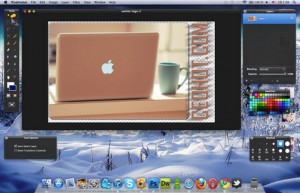Two Easy Ways to Create Transparency
 The most common method for making a background transparent back in Photoshop 6.0 is still available to you in Photoshop CS, and that’s to go to the Layers palette and simply delete the background layer.
The most common method for making a background transparent back in Photoshop 6.0 is still available to you in Photoshop CS, and that’s to go to the Layers palette and simply delete the background layer.
That’s it. This leaves only the layers that were above the background layer (which already have background transparency). Now, there’s another easy way, and that’s to go to Photoshop’s Save for Web command, switch to the eyedropper tool in the Save for Web’s Toolbox, and click on the background color you want to be transparent. Then, just below the Color table on the bottom right of the dialog, click on the first icon, which creates transparency from your selected color.
Where To Set Custom Views
Although you can choose Custom Thumbnail Size from the File Browser’s View menu, that custom size is set by Adobe to 256 pixels. But if it says "custom," surely you have to be able to customize it, right? Right! Just go under the File Browser’s Edit menu and choose Preferences. When the Preferences dialog appears, you’ll see a field for Custom Thumbnail Size. Highlight this field, enter your new default size, and click OK. Now when you choose Custom Thumbnail Size from the View menu, it will use your size (rather than the old def.
The Advantage Of Photo Filter Adjustment Layers
One of the most brilliant things Adobe did when they added Photo Filters to Photoshop CS (these filters replicate the old traditional screw-on lens filters) was to make them Adjustment Layers. By doing this, after you apply the Photo Filter (let’s say, for example, you used the 81 filter to warm a cool photo), you can get the Brush tool, set your Foreground color to black, and paint over any areas of the photo you don’t want to be warmed. This gives you a level of flexibility you wouldn’t get any other way.
The Gaussian Blur Keyboard Shortcut
I thought that would get your attention. That’s because you know there’s no keyboard shortcut for applying a Gaussian Blur. But there is in my copy of Photoshop CS. How is that possible? Because I created one, and you can too. Just go under the Edit menu and choose Keyboard Shortcuts to bring up the Keyboard Shortcuts editor. Then, from the Shortcuts For pop-up menu, choose Application Menus. In the list of menus in the window beneath it, click on the gray, right-facing triangle next to Filter to reveal all the choices under the Filter menu. Scroll down to Gaussian Blur, then click on the name. This brings up a field where you can enter the shortcut by pressing the keys you want to use. I recommend using the Shift-Option-Command-G because there are so few shortcuts not already being used by Photoshop. Click OK, and not only is the shortcut activated but your custom shortcut now appears in the Filter menu to the right of Gaussian Blur.
Resizing Paths The Easy Way
When you’re using the Pen tool, you can visually resize your path by using the Path Selection tool. To do this, go up in the Options Bar and turn on the checkbox for Show Bounding Box. This puts a Free Transform-like bounding box around your path, and you can use this bounding box to resize your path by dragging the handles (remember to hold the Shift key to resize it proportionately).


No comments
Be the first one to leave a comment.